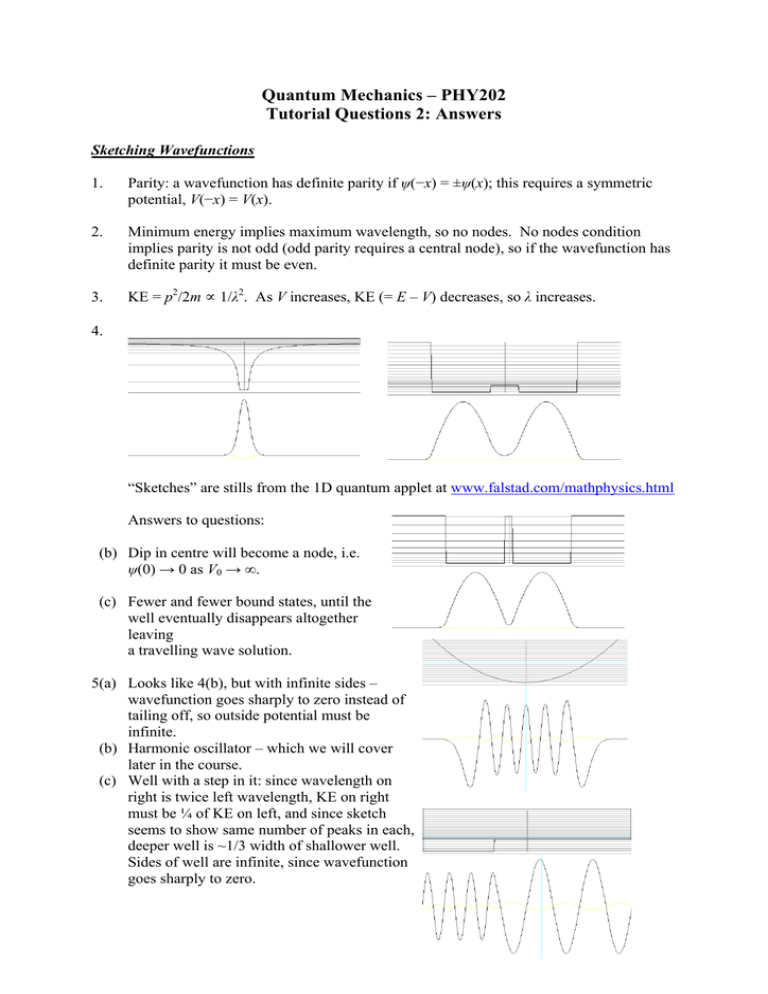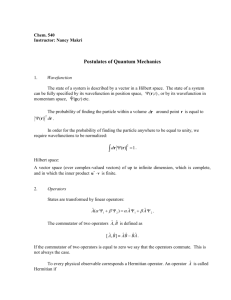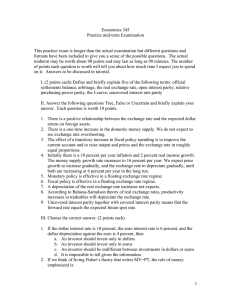Quantum Mechanics – PHY202 Tutorial Questions 2: Answers
advertisement

Quantum Mechanics – PHY202 Tutorial Questions 2: Answers Sketching Wavefunctions 1. Parity: a wavefunction has definite parity if ψ(−x) = ±ψ(x); this requires a symmetric potential, V(−x) = V(x). 2. Minimum energy implies maximum wavelength, so no nodes. No nodes condition implies parity is not odd (odd parity requires a central node), so if the wavefunction has definite parity it must be even. 3. KE = p2/2m ∝ 1/λ2. As V increases, KE (= E – V) decreases, so λ increases. 4. “Sketches” are stills from the 1D quantum applet at www.falstad.com/mathphysics.html Answers to questions: (b) Dip in centre will become a node, i.e. ψ(0) → 0 as V0 → ∞. (c) Fewer and fewer bound states, until the well eventually disappears altogether leaving a travelling wave solution. 5(a) Looks like 4(b), but with infinite sides – wavefunction goes sharply to zero instead of tailing off, so outside potential must be infinite. (b) Harmonic oscillator – which we will cover later in the course. (c) Well with a step in it: since wavelength on right is twice left wavelength, KE on right must be ¼ of KE on left, and since sketch seems to show same number of peaks in each, deeper well is ~1/3 width of shallower well. Sides of well are infinite, since wavefunction goes sharply to zero. Operators and Measurement 6. Give examples of eigenvalue equations, stating eigenvalues and eigenfunctions, for (a) the energy operator (b) the momentum operator (c) the parity operator Obvious examples for (a) are the infinite square well 0 < x < L, (since V(x) = 0), where and , or the infinite square well −L/2 < x < L/2 (results see Tutorial Questions 1, Q3). They have also done the finite square well and the harmonic oscillator. Obvious example for the momentum operator, where , is the plane wave u(x) = Aeikx, with eigenvalue p = k. For parity, , the eigenvalues are P = ±1, and any symmetric or antisymmetric solution is an eigenfunction. The obvious concrete example is the symmetric infinite square well. 7. Suppose that φ (x) is a travelling wave, Aexp(ikx). 1 (a) Show that this is an eigenstate of the momentum operator. What is its momentum? See above. (b) What is φ (x) = Ae−ikx. ? (where is the parity operator). 2 (c) Using φ (x) and φ (x) construct states of definite parity. 1 2 ψ(x) = (φ1 ± φ2)/√2, the + sign having P = +1 and vice versa. (d) Show that these states of definite parity satisfy the parity eigenvalue equation. Trivial. 8. A particle in an infinite square well, V(x) = 0 for 0 < x < L, V(x) = ∞ otherwise, has the time independent wavefunction (a) By exploiting the orthonormality of the expansion functions, find the value of the normalization factor A. Write the equation as eigenstates properly. Then we have to normalise the , from which . (b) If a measurement of the energy is made, what are the possible results? What is the probability associated with each result? and , with probabilities 0.8 and 0.2 respectively. (c) Using the results of (b) deduce the average energy and express it as a multiple of the energy E1 of the lowest eigenstate. 0.8E1 + 0.2(4E1) = 1.6E1. (d) Calculate the expectation value of E using and verify that this is identical to the result of (c). , so . Multiplying the integrand out and using double angle formulae reduces the integral to ; all the cos terms contribute zero (they integrate to sines, which are zero at 0 and L by the boundary conditions), so we wind up with , as expected. (e) If the energy is measured, as in (b), what is the form of the wavefunction after the measurement? Either (80% probability) or (20% probability), depending on the outcome of the measurement. (f) If the energy is immediately re-measured, what will be the probabilities of the possible outcomes now? The re-measurement gives the same value as the original measurement, with 100% probability. 9. What does it mean to say that certain operators commute? Give examples of operators that commute and of operators that do not commute. (Hint, see also Q.2.) Definition: operators commute if , i.e. the order does not matter. Significance: observables corresponding to commuting operators can be measured simultaneously, whereas those corresponding to non-commuting operators have an uncertainty principle. Examples: commuting pairs, momentum and energy, energy and parity; non-commuting pairs, momentum and position, energy and time. 10. Use the uncertainty principle to explain, in the simplest terms, why a zero point energy is observed for any particle in a bound state. A bound state is by definition confined to a certain region of space, so Δx ≠ ∞. Therefore, since Δx Δp ~ , we have a minimum Δp ~ /L where L is the width of the bound state. But Δp = 〈p2〉 − 〈p〉2, so the minimum value of 〈p2〉 is ~ 2/L2. Therefore we must have a minimum energy ~ 2/2mL2, from E = p2/2m.








